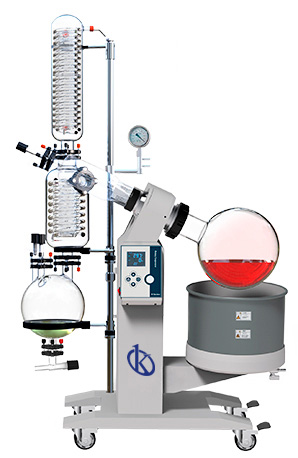The sciences have always been considered the essence of significant innovations that have revolutionized the world. An essential aspect of the sciences is the equipment and tools used to transform theoretical concepts into tangible practices. One such essential piece of equipment in laboratory life is the rotary evaporator. Highly versatile and efficient, this equipment has significantly changed the workflow in many laboratories around the world.
A rotavaporator, also known as a rotavap or rotovap, is a device used in chemical and biochemical laboratories for the gentle and efficient removal of solvents from samples. Created by the brilliant mind of Swiss inventor Lyman C. Craig during the 1950s, this instrument has proven invaluable in even the most complex laboratory processes.
How do Rotavapors work?
Rotavapors operate on the principle of rotary distillation, a technique used to separate mixtures. This process is carried out under low pressure conditions, which allows solvents to evaporate at lower temperatures, thus minimizing the risk of thermal degradation. The sample is placed in a flask that is constantly rotating, creating a thin film on the inner surface of the flask, thus increasing the evaporation surface.
The rotation also serves to mix the sample, facilitating the homogeneous evaporation of the solvents present. Subsequently, the vapor is condensed in a condenser and collected in a separate vessel, leaving the sample without solvent.
Applications of Rotavapors in Laboratory Processes
In any chemical or life science laboratory, rotary evaporators are essential for carrying out a number of processes. They are especially useful in the purification of heat-sensitive products, as they allow the removal of solvents at low temperatures.
Rotavapors are essential in many extraction procedures, where solvents are used to extract compounds of interest from samples. After extraction, solvents can be efficiently removed using a rotary evaporator, providing an efficient means to recover the compound of interest in its purest state.
In addition, by using a rotary evaporator, scientists can concentrate samples quickly and efficiently. This process is particularly essential when preparing samples for analysis, as it allows scientists to concentrate their sample to the required volume, thereby increasing the accuracy and efficiency of their analysis.
Rotavapors and the Future of Laboratory Processes
The need to achieve accurate and fast results in laboratories implies the continued evolution and advancement of the tools and equipment used. Rotary evaporators are no exception. With the increasing demand for more accurate and efficient control of laboratory processes, technological innovation must keep pace. The use of rotary evaporators has proven to be a mainstay in the efficient operation of laboratories and will undoubtedly continue to do so.
The history of rotary evaporators is a clear example of how scientific tools can evolve and improve over time to adapt to the changing needs of the laboratory. From their invention to their current use, rotary evaporators have proven time and again their unmatched value and versatility, making them an essential part of any modern laboratory.
Kalstein Rotary evaporators
In Kalstein we have for you a YR series of high quality Rotavaporators that covers the highest requirements of the laboratories, as we are MANUFACTURERS of laboratory equipment we guarantee excellent price, and advice at the time of sale, learn more about our equipment HERE.

